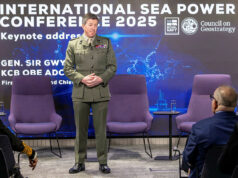The UK Defence Committee convened a session to examine the Ukraine conflict, 1,000 days after Russia’s full-scale invasion began.
Experts, including Dr Patricia Lewis, Air Marshal Edward Stringer (Ret’d), and Orysia Lutsevych OBE, provided insights into the war’s trajectory, the toll it has taken, and potential outcomes for the years ahead.
Opening the session, the Chair laid out the devastating human cost of the conflict.
“Around 150,000 Russians are estimated to have been killed, with 250,000 to 300,000 seriously injured. Ukrainian losses are similarly staggering, estimated at half to two-thirds of these numbers,” he stated. Adding to the complexity, he highlighted the involvement of “thousands of North Korean troops on European soil, and Russia recruiting mercenaries from Yemen, India, and Nepal, often forcibly.”
Dr Patricia Lewis, a former director at Chatham House, described the conflict’s potential outcomes as ranging from continued stalemate to decisive victory for either side. “One plausible outcome is for there to be no outcome,” she explained, outlining the possibility of ongoing hostilities with minimal territorial changes but enormous human and economic costs.
She also raised the prospect of a negotiated ceasefire, albeit with significant challenges. “For Ukraine to now give up the idea of joining NATO or to be fobbed off with long-term NATO membership would be a very difficult thing to accept,” Dr Lewis warned, emphasising the importance of security guarantees given Russia’s history of violating agreements like the Budapest Memorandum.
Air Marshal Edward Stringer echoed Dr Lewis’s analysis but pointed to the deteriorating state of Russia’s military. “Russia is burning through its stocks of equipment, including 300 gun barrels a month, while their forges can only produce 20,” he noted, adding that the country’s economic challenges would further strain its war effort. However, he cautioned that these limitations might not result in immediate changes on the battlefield.
“A very plausible outcome is the ‘no outcome,’ with both sides exhausted and entrenched in a frozen conflict,” he said, predicting minimal movement of the frontline and continued, albeit reduced, casualties. The potential influence of a Trump Administration in the United States was identified as a major variable, adding unpredictability to the situation.
Both experts agreed that Russia’s aggression has strengthened NATO rather than weakened it. “If Russia has done one thing with this war, apart from lose 150,000 of its people, it has strengthened NATO,” Dr Lewis remarked, highlighting the alliance’s bolstered unity and resolve.
Yet, the long-term implications remain concerning. Air Marshal Stringer stressed the importance of preparation: “We are not ready for what is coming our way in four to five years. Regardless of the outcome of this war, we will not be safe in the future unless we are prepared to deal with danger.”














Watch Trump. Ukraine is in debt for a century, too many corporate opportunities to pass up in reconstruction. And some of the richest farmland on the planet. I would stick my neck out and predict a condition of cessation will be Russia keeping what its got, and Ukraine being considered a neutral entity without Nato membership. Ever.
All the Putin fanboys coming out of the woodwork to spout disgusting pro-putin propaganda.
That’s good. I feel better now that a committee has taken over planning for the future. Probably be ready with several different decisions within years.
Putin’s ultimate aim is to topple the UKR government in Kiev and replace it with one loyal to Russia.
If he succeeds then Russia (and a turned UKR army) will be right at NATO’s border, and with weapons that we provided.
There are many ways he can attempt this, not just by gaining and occupying Ukrainian territory, that is just part of his strategy to demoralise the UKR population by making them war-weary and fed-Up with Zelensky. I think another problem is the incoming POTUS will unwittingly help Russia’s geopolitical ambitions.
The possible outcomes as I see it.
1) War carries on as it is: Russia will gain more ground, but one more year of attrition losses (if UKR can hold out) will finally deplete Russia’s military might. – Territorial stalemate but Ukraine wins (tactically)
2) UKR front lines collapse under attritional pressure (or UKR runs out ammo/troops/weapons) – Putin wins
3) Cease-fire / Truce: with no return of land to UKR and no NATO membership – Putin wins, and starts planning the next phase.
4) Cease-fire with UKR getting NATO membership Stalemate but best option for UKR.
Let’s wait and see the NSA Mike Waltze and the special envoy to Ukraine Gen Kellogg are both strong supporters of Kiev!
Trump is also not opposing the extra aid going Ukraines way at the moment because he can use this in leverage in any talks with Poootin!
BoF, yours is a better listing of potential outcomes than that provided by ‘the experts’.
I’d go with option 3 .
Deem that any variation of scenario 1 which results in the collapse of Russian military would be the most destabilizing and dangerous outcome. Mad Vlad would certainly consider that to be an existential threat to his continued rule, and hence, by extension, an existential threat to the state. A wounded bear in possession of practically unlimited nuclear weapons could be the basis of a chilling Grimm’s Tale. 🤔😱
Experts… yeah right. No doubt their pages of notes goes on a little more than listed, however, the conclusions drawn were quite feeble really.
It truly isn’t rocket science to list the possibly outcomes, as well as how those outcomes would benefit Russia, Ukraine and indeed the west. As already said, I think BoF has pretty much outlined the most credible outcomes ‘available’ in this conflict.
I think the numbers for Ukrainian casualties are way off. Too high.
For Russia the fall of ukraine to NATO is exsistential. I will use nukes if.needed. The westvare stupido
If you believe this article you will believe anything.